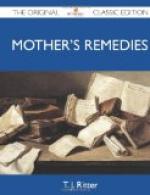Flowers.—Flowers are usually ordered the day before the funeral, to arrive in the morning, that they may be fresh. Cards are removed before they are taken to the cemetery. Colored flowers, preferably those of pale tints, are admissible, though American Beauties are not infrequently sent. Wreaths of galax leaves are often ordered for the funeral of an elderly person; sometimes half of the wreath is of the leaves and the remainder of flowers. Wreaths and sprays are almost invariably sent by private individuals, the stereotyped “emblems” like “the broken wheel,” “gates ajar,” etc., being the offerings of clubs, or other organizations to which the deceased may have belonged. Where there is a great quantity of flowers, the loose sprays are often sent to the sick in hospitals, only enough to cover the grave being reserved. The visitor to a cemetery could find it in his heart to wish that when the beauty of these floral offerings has departed, the sodden remnants might be speedily removed. They speak so forcibly of forgetfulness.
MOURNING GARMENTS.
The custom of wearing mourning after a bereavement is almost universal. Even the poorest endeavor to show their grief by donning a few shreds of black, while among the well-to-do an entire new wardrobe is felt to be obligatory. However our religion bids us look forward to a more perfect existence in the beyond, however truly death may be a relief from pain and suffering, custom, that makes cowards of us all, must be followed. Often too, mourning garb is but the visible evidence of the gloom that oppresses us spiritually. In spite of our faith, our sense of loss and loneliness is best expressed in sad raiment and abstinence from pleasures. Often it would be kindness to the living to go our way as usual, but that is not in harmony with our hearts.
Mourning is in a manner a protection to a woman. Strangers respect her sorrow and refrain from the jocular. Behind her crepe she may defy intrusion. But it often becomes a hardship to the young.
[752 Mothers’ remedies]
“I missed all my youth,” complained a middle-aged woman. “We were a large family. A brother died when I was sixteen and we went into mourning and shut ourselves away from entertainments. Then my father died; next a sister, and another brother, so that, looking back, I can remember but one gown I had, between the age of sixteen and thirty-one, that was not black—and the one exception never had a chance to get worn out.”
The Expense of Mourning.—Mourning, however, is sometimes a distraction. In deciding about trimmings and the width of crepe hems many a woman forgets her woe, for a time at least. Mourning wear is expensive, and to clothe a whole family in black totals no inconsiderable sum. Many families have been financially swamped through the expenses of an illness, a burial, and the conventional mourning. In this instance, as in the case of weddings, all these things should be regulated by common sense. A costly casket, a profusion of flowers and a long funeral procession merely gratify a foolish and ostentatious pride on the part of the survivors, and often entail a heavy burden on the father or husband.




